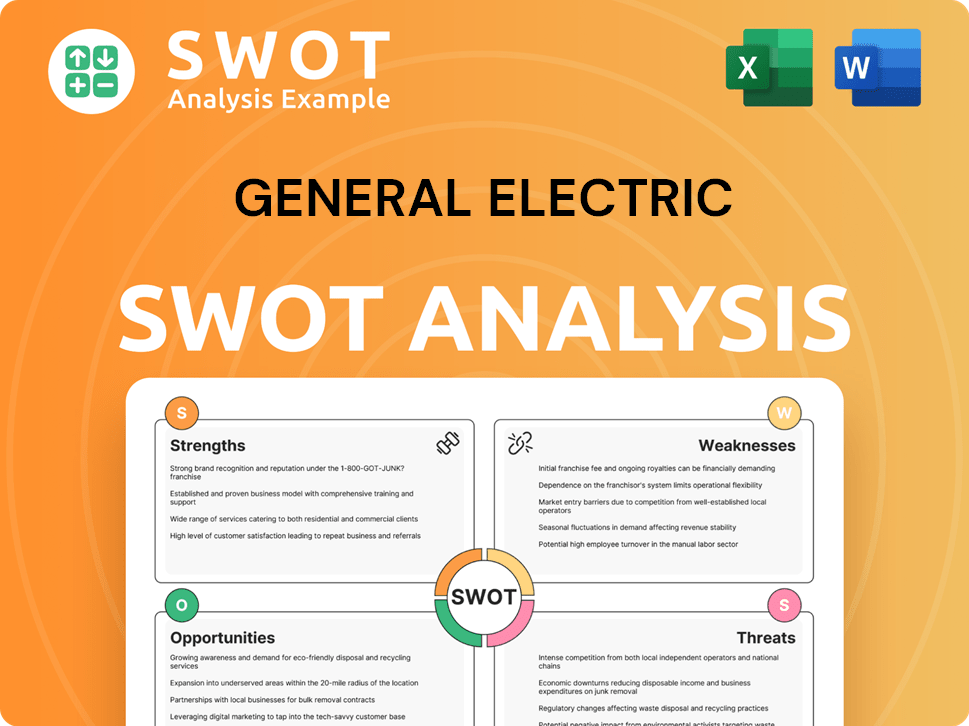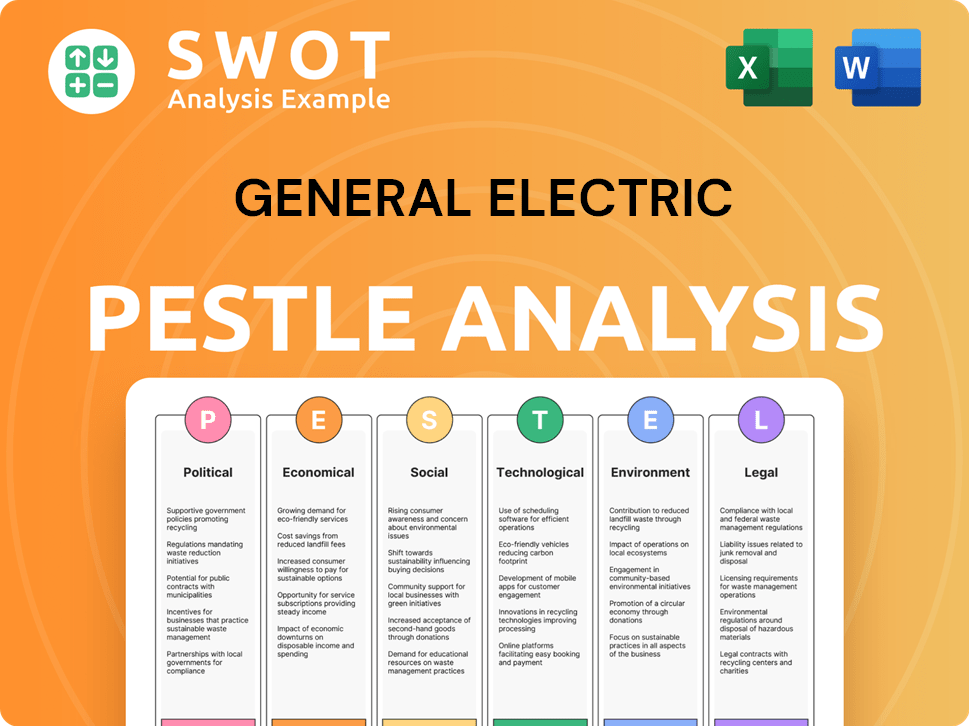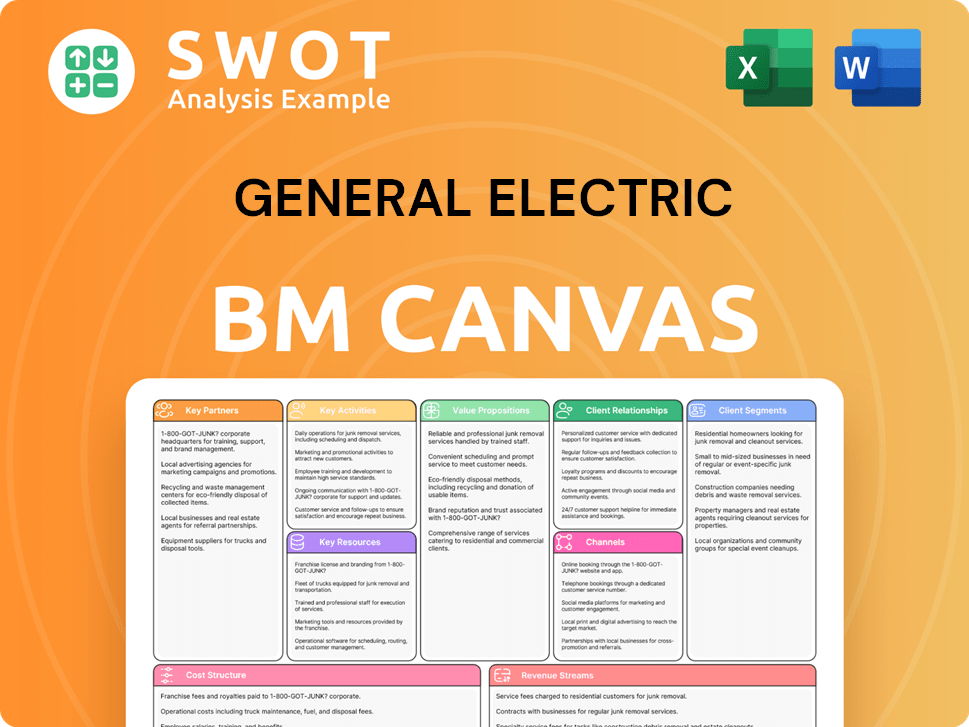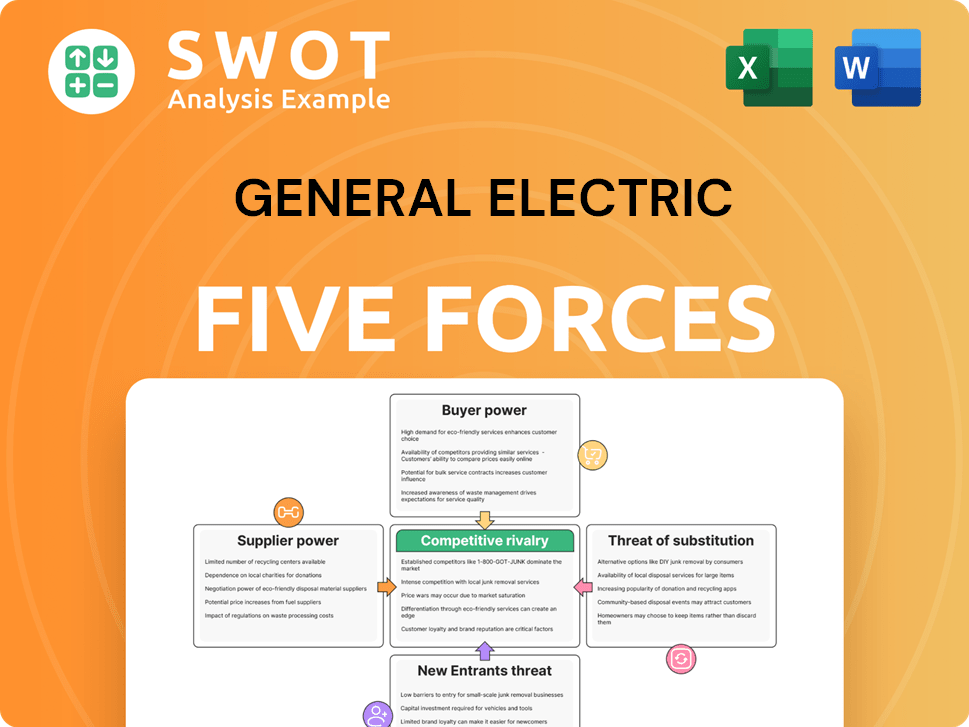General Electric Bundle
Who Buys From the New General Electric?
In today's dynamic business landscape, understanding your customer is key, and for a company like General Electric, that understanding is critical to survival. From its humble beginnings to its 2024 transformation, GE's customer base has drastically evolved. This shift demands a deep dive into who these customers are now and how GE caters to their specific needs.

This exploration of General Electric SWOT Analysis will illuminate the intricacies of GE's customer demographics and target market, providing valuable insights for investors, analysts, and strategists alike. We'll dissect the GE customer profile across its core sectors: GE Aerospace, GE Vernova, and GE HealthCare, revealing the company's strategic market segmentation and how it adapts to serve its diverse customer base. Discover the demographic analysis of General Electric's clientele and gain a clearer picture of GE's ideal customer in 2024 and beyond.
Who Are General Electric’s Main Customers?
Understanding the Growth Strategy of General Electric involves a deep dive into its customer demographics and target market. The company, now structured into three distinct entities—GE Aerospace, GE Vernova, and GE HealthCare—primarily operates in the business-to-business (B2B) sector. This strategic focus allows each entity to tailor its offerings to the specific needs of its diverse customer base, which is a key aspect of GE's market segmentation.
The customer demographics of General Electric are largely defined by the industries it serves. Each of GE's business units targets specific sectors, including aerospace, energy, and healthcare. This targeted approach is crucial for understanding who the target audience for GE products is and how the company adapts its strategies to meet their needs. The demographic breakdown of GE's consumer base is therefore highly specialized, reflecting the unique requirements of each industry.
GE's customer profile is characterized by large organizations with complex needs. These customers require technologically advanced and reliable products and services. The shift to independent companies allows each entity to more precisely cater to the unique characteristics and evolving demands of its specific B2B customer base, which is crucial for GE's success.
GE Aerospace's target market primarily includes airline operators, aircraft manufacturers like Boeing and Airbus, and defense organizations. In 2024, GE Aerospace reported strong financial performance with double-digit orders and adjusted revenue growth. Its products include engines and avionics systems. The company's large installed base of over 45,000 engines, powering three out of every four commercial flights, demonstrates its significant market share within this segment.
GE Vernova focuses on power generation companies, utilities, and industrial clients. Its segments include Power, Renewable Energy, and Electrification. In 2024, GE Vernova's orders were $44.1 billion and revenue was $34.9 billion, with significant growth in Power and Electrification. The company's technology generates approximately 25% of the world's electricity. GE Vernova is seeing accelerated demand in Electrification, particularly for grid investments.
GE HealthCare targets healthcare institutions, hospitals, and medical professionals. Its offerings include medical imaging equipment, patient care solutions, and digital healthcare solutions. In 2024, GE HealthCare reported revenues of $19.7 billion, with growth driven by Advanced Visualization Solutions and Pharmaceutical Diagnostics. The company serves approximately 1 billion patients annually and has around 5 million units installed globally.
The customer demographics of GE's industrial products are characterized by their scale and complexity. These are large organizations with significant capital expenditures and long-term investment horizons. The specific needs vary widely, from the precise requirements of aviation clients to the regulatory demands of healthcare providers. GE's marketing strategies for different demographics are highly specialized, reflecting the unique needs of each sector. Understanding these key demographics is crucial for GE's continued success.
GE's customer base is primarily B2B, segmented by industry. Each business unit—GE Aerospace, GE Vernova, and GE HealthCare—serves distinct sectors with specialized products and services. This focus allows GE to tailor its offerings to the unique needs of its customers.
- GE Aerospace targets the aviation and defense industries, with strong demand in 2024.
- GE Vernova serves the energy sector, with significant growth in Power and Electrification.
- GE HealthCare focuses on healthcare institutions, with growing revenues in 2024.
- GE's customer demographics are defined by the industries they serve, with a focus on large organizations requiring advanced technology.
General Electric SWOT Analysis
- Complete SWOT Breakdown
- Fully Customizable
- Editable in Excel & Word
- Professional Formatting
- Investor-Ready Format

What Do General Electric’s Customers Want?
Understanding the customer needs and preferences is crucial for the success of any company, and for General Electric (GE), this is particularly true given its diverse portfolio of products and services across various industries. The company's focus on innovation, reliability, and customer satisfaction is evident in its approach to meeting the specific needs of its varied customer base. This customer-centric approach is essential for maintaining its market position and driving future growth.
GE's ability to tailor its offerings to specific customer needs is a key element of its strategy. The company's commitment to research and development, along with its focus on long-term service and support, underscores its dedication to providing value to its customers. This approach is crucial for maintaining and expanding its market share in a competitive environment.
For GE, the customer's needs drive product development and service offerings across its business segments. This customer-focused strategy is evident in how GE designs, manufactures, and supports its products and services, ensuring they meet the evolving demands of its diverse customer base. This is a key factor in GE's sustained success and market leadership.
Customers of GE Aerospace prioritize safety, quality, and timely delivery. They also seek advanced technology that enhances fuel efficiency and operational uptime for their aircraft fleets. The demand for commercial aircraft engines remains strong, boosted by global passenger traffic.
GE Vernova's customers, mainly utilities and power producers, need reliable, affordable, and sustainable energy solutions. This includes advanced gas and steam turbines, along with renewable energy technologies. The increasing demand for grid investments highlights the need for reliable electricity systems.
GE HealthCare's customers, which are hospitals and healthcare providers, require precise diagnostic capabilities, efficient patient care solutions, and advanced medical technology. Innovation in medical imaging, pharmaceutical diagnostics, and digital health solutions are key priorities. GE HealthCare invests over $1.3 billion in R&D to address unmet needs.
GE emphasizes understanding unique customer needs and tailoring solutions accordingly. This approach is evident in offerings like appliances with Spanish language panels, which are designed with the needs of U.S. Hispanic households in mind. This customer-centric culture is a key driver of GE's success.
GE's investment in research and development is central to meeting customer needs. This includes creating cutting-edge products and solutions for the energy transition. GE's commitment to innovation ensures it remains competitive and meets evolving customer demands.
GE's focus on long-term service support is critical, particularly in high-stakes environments. This includes reducing turnaround times for maintenance, repair, and overhaul (MRO) to minimize downtime. This commitment to support builds customer loyalty and ensures operational efficiency.
The Brief History of General Electric shows how the company has adapted its strategies to meet the changing needs of its customers. GE's ability to understand and respond to these needs is fundamental to its business model and its ongoing success in the global market. This customer-focused approach is critical for maintaining a competitive edge and driving innovation across all its business segments.
Understanding the customer demographics and preferences is vital for GE's strategic planning. This involves analyzing the specific needs of each customer segment to tailor products and services effectively. The company's approach to understanding its customer base allows for targeted marketing and product development.
- GE Aerospace: Focuses on airlines and aircraft operators, emphasizing safety, fuel efficiency, and operational reliability.
- GE Vernova: Targets utilities, power producers, and grid operators, with a focus on reliable, affordable, and sustainable energy solutions.
- GE HealthCare: Serves hospitals and healthcare providers, prioritizing advanced medical technology and improved patient outcomes.
- Industrial Products: The customer base includes a wide range of industries, such as aviation, energy, and healthcare, all of which require high-performance, reliable, and efficient equipment.
- Customer Age Range and Income Levels: While specific age ranges and income levels vary across GE's customer base, the company generally targets organizations and businesses rather than individual consumers.
- Marketing Strategies: GE employs different marketing strategies based on the specific needs of each customer segment, ensuring that its products and services meet the unique requirements of each group.
General Electric PESTLE Analysis
- Covers All 6 PESTLE Categories
- No Research Needed – Save Hours of Work
- Built by Experts, Trusted by Consultants
- Instant Download, Ready to Use
- 100% Editable, Fully Customizable

Where does General Electric operate?
General Electric (GE) maintains a significant global geographical market presence, operating in over 170 countries as of 2024. This expansive reach is a key characteristic of its business model, allowing it to serve diverse customer demographics and adapt to regional market dynamics. The company's market presence is further segmented across its specialized business units: GE Aerospace, GE Vernova, and GE HealthCare.
The geographical distribution of GE's revenue highlights its strong global footprint. While specific revenue breakdowns for each newly formed independent company offer a more granular view, the overarching trend indicates significant market penetration across North America, Europe, and Asia-Pacific. This widespread presence is supported by numerous manufacturing facilities and strategic partnerships.
GE's approach involves localizing its offerings and marketing strategies through partnerships with local companies. This strategy is designed to gain access to new customer segments and maintain relevance within local markets. This approach is crucial for effectively targeting the diverse customer demographics that GE serves worldwide.
GE Aerospace's global reach is extensive, with an installed base of over 45,000 engines. Its presence is supported by MRO facilities and investments distributed across the United States, South America, Europe, the Middle East, and Asia Pacific. This widespread infrastructure ensures support for commercial flights across numerous countries, demonstrating GE's commitment to serving its global customer base.
GE Vernova plays a crucial role in the global power and renewable energy sectors, with its technology generating approximately 25% of the world's electricity. The company's largest market for its Grid Solutions business is Europe, and it is also experiencing significant growth in North America. GE Vernova is investing nearly $600 million over the next two years in U.S. factories and facilities to meet surging customer demands both domestically and internationally.
GE HealthCare serves approximately 1 billion patients annually and has around 5 million units installed globally. The U.S. market remains a strong area for the company, although it has experienced market softness in China. This global presence highlights GE HealthCare's commitment to providing healthcare solutions worldwide and serving diverse customer demographics.
In fiscal year 2024, the revenue breakdown by region showed that 'Non-US' was the largest region, representing 37.17% of its revenue, followed by the United States at 30.17%. Europe contributed 13.57%, China 6.32%, the Middle East and Africa 6.5%, and Asia (excluding China) 6.27%. These figures highlight the global distribution of GE's sales, with significant market penetration across North America, Europe, and Asia-Pacific.
General Electric Business Model Canvas
- Complete 9-Block Business Model Canvas
- Effortlessly Communicate Your Business Strategy
- Investor-Ready BMC Format
- 100% Editable and Customizable
- Clear and Structured Layout

How Does General Electric Win & Keep Customers?
General Electric (GE) employs a sophisticated, multi-faceted approach to customer acquisition and retention, particularly focusing on its B2B operations. This strategy is heavily influenced by innovation, customer-centricity, and strategic partnerships. GE's understanding of its customer demographics and the General Electric target market is critical for its sustained success.
For customer acquisition, GE leverages targeted marketing campaigns, especially in sectors like aviation, healthcare, and energy. These efforts involve direct marketing to key decision-makers, digital marketing, and a strong online presence. GE also emphasizes thought leadership through whitepapers and industry events to reinforce its reputation. Strategic collaborations are essential for expanding its reach and penetrating new customer segments.
Retention strategies are deeply integrated into GE's organizational culture, prioritizing customer satisfaction and long-term relationships. This includes a consultative approach, where sales and technical teams work closely with clients to understand their unique needs. Continuous innovation, driven by customer feedback, ensures that offerings meet evolving needs. Exceptional after-sales service and support are also critical for retaining customers in its high-tech industrial sectors.
GE focuses on direct marketing to key decision-makers in sectors such as aviation, healthcare, and energy. This targeted approach ensures that the right products and services reach the appropriate audience. This strategy is vital for acquiring new clients and maintaining relationships.
GE heavily invests in digital marketing, including social media campaigns, to promote its brand and products. Digital ad spending was approximately $500 million in 2024. This approach enhances brand visibility and engagement with potential customers.
GE shares its expertise through whitepapers and participation in industry events. This strategy reinforces its reputation for innovation and knowledge. It helps in positioning GE as a leader in its core sectors.
Collaborations are vital for expanding reach and accessing new customer segments, particularly in healthcare and other diverse markets. These partnerships allow GE to enter new markets and offer comprehensive solutions.
GE's commitment to customer retention is evident in its customer-centric culture. The company prioritizes customer satisfaction and builds strong, long-term relationships. This involves a consultative approach where sales and technical teams work closely with clients to understand their unique needs and identify tailored solutions. GE’s dedication to innovation and continuous product development, influenced by customer feedback and market trends, ensures that offerings meet evolving needs. For example, in 2024, GE Appliances showcased intuitive designs based on consumer wants and needs, including appliances with Spanish language panels for U.S. Hispanic households. Additionally, long-term contracts and service agreements are standard in industries like aviation, energy, and healthcare, providing recurring revenue and fostering enduring relationships. GE Aerospace, for example, is investing over $1 billion over five years in its Maintenance, Repair and Overhaul (MRO) facilities worldwide to reduce turnaround times and expand repair capabilities, directly enhancing customer service and loyalty. Exceptional after-sales service and support are critical for retaining customers in its high-tech industrial sectors.
Sales and technical teams work closely with clients to understand unique needs and identify tailored solutions. This approach builds trust and ensures customer satisfaction. It helps GE to offer customized solutions.
GE continuously develops its products based on customer feedback and market trends. This ensures that offerings meet evolving needs. Innovation is key to maintaining a competitive edge.
Long-term contracts and service agreements provide recurring revenue and foster enduring relationships. This is particularly important in industries like aviation and energy. They ensure a stable revenue stream.
Exceptional after-sales service and support are critical for retaining customers in high-tech industrial sectors. This includes maintenance, repairs, and technical assistance. Excellent service enhances customer loyalty.
GE actively uses customer feedback to improve products and services. This ensures that the company remains customer-focused and responsive to market demands. This helps in adapting to changing market needs.
GE Aerospace is investing significantly in its Maintenance, Repair, and Overhaul (MRO) facilities. This investment enhances customer service and loyalty. It ensures the longevity of customer relationships.
GE's customer acquisition and retention strategies are essential for its success. These strategies are designed to build strong relationships and ensure customer satisfaction.
- Targeted B2B marketing to reach key decision-makers.
- Digital marketing and a strong online presence for brand visibility.
- Industry thought leadership to establish expertise.
- Strategic partnerships to expand market reach.
- Customer-centric culture with a focus on long-term relationships.
- Continuous innovation based on customer feedback.
- Exceptional after-sales service and support.
Understanding the GE customer profile and the specific needs of each segment allows GE to tailor its marketing and service offerings effectively. This includes detailed demographic analysis General Electric to understand the GE customer base better. For a deeper dive into the competitive landscape, consider reading about the Competitors Landscape of General Electric.
General Electric Porter's Five Forces Analysis
- Covers All 5 Competitive Forces in Detail
- Structured for Consultants, Students, and Founders
- 100% Editable in Microsoft Word & Excel
- Instant Digital Download – Use Immediately
- Compatible with Mac & PC – Fully Unlocked

Related Blogs
- What are Mission Vision & Core Values of General Electric Company?
- What is Competitive Landscape of General Electric Company?
- What is Growth Strategy and Future Prospects of General Electric Company?
- How Does General Electric Company Work?
- What is Sales and Marketing Strategy of General Electric Company?
- What is Brief History of General Electric Company?
- Who Owns General Electric Company?
Disclaimer
All information, articles, and product details provided on this website are for general informational and educational purposes only. We do not claim any ownership over, nor do we intend to infringe upon, any trademarks, copyrights, logos, brand names, or other intellectual property mentioned or depicted on this site. Such intellectual property remains the property of its respective owners, and any references here are made solely for identification or informational purposes, without implying any affiliation, endorsement, or partnership.
We make no representations or warranties, express or implied, regarding the accuracy, completeness, or suitability of any content or products presented. Nothing on this website should be construed as legal, tax, investment, financial, medical, or other professional advice. In addition, no part of this site—including articles or product references—constitutes a solicitation, recommendation, endorsement, advertisement, or offer to buy or sell any securities, franchises, or other financial instruments, particularly in jurisdictions where such activity would be unlawful.
All content is of a general nature and may not address the specific circumstances of any individual or entity. It is not a substitute for professional advice or services. Any actions you take based on the information provided here are strictly at your own risk. You accept full responsibility for any decisions or outcomes arising from your use of this website and agree to release us from any liability in connection with your use of, or reliance upon, the content or products found herein.